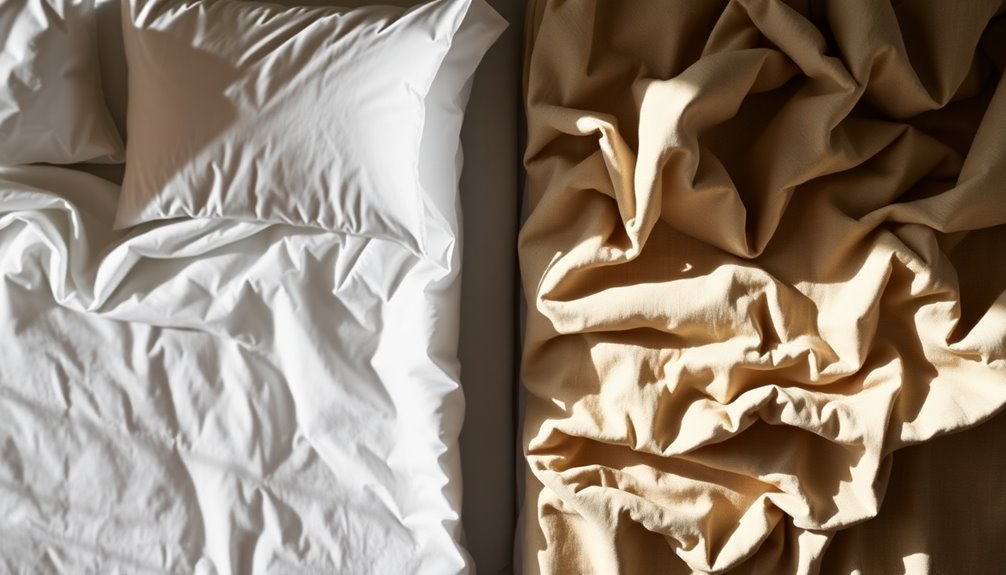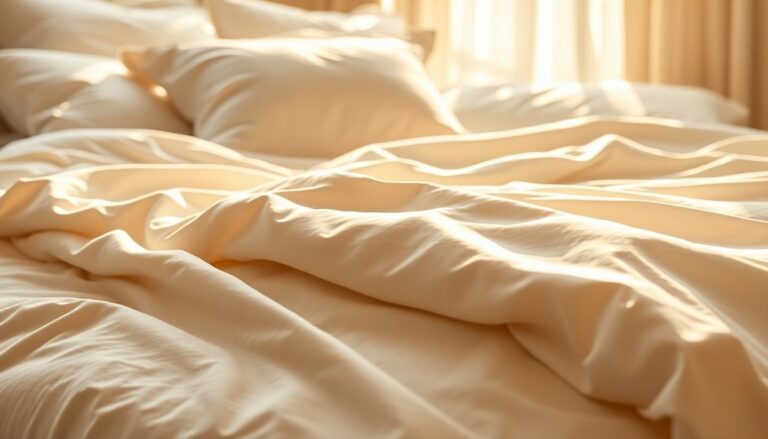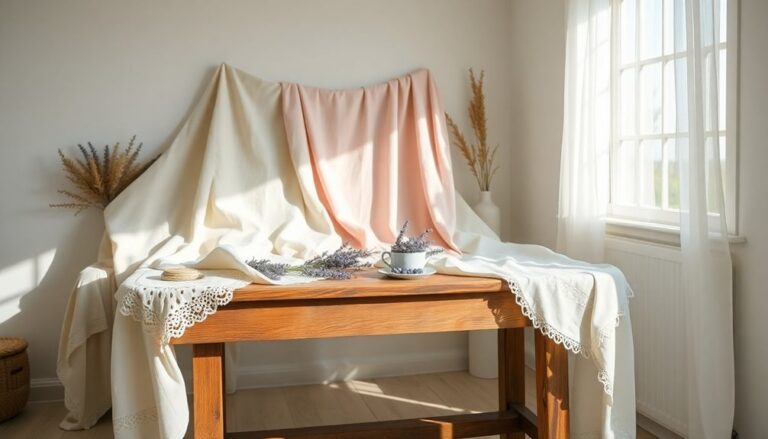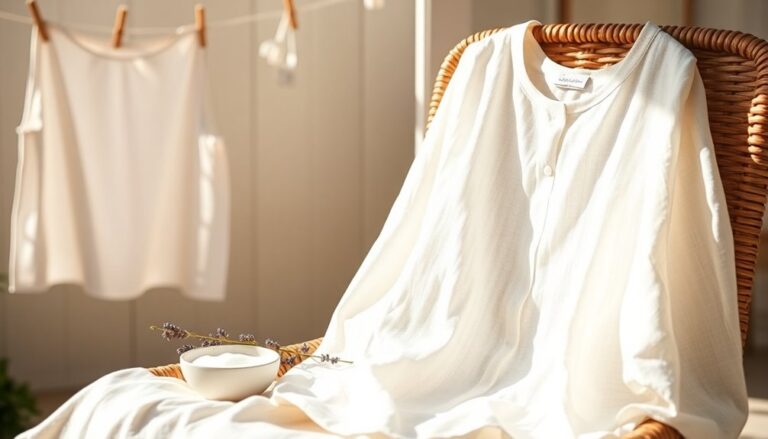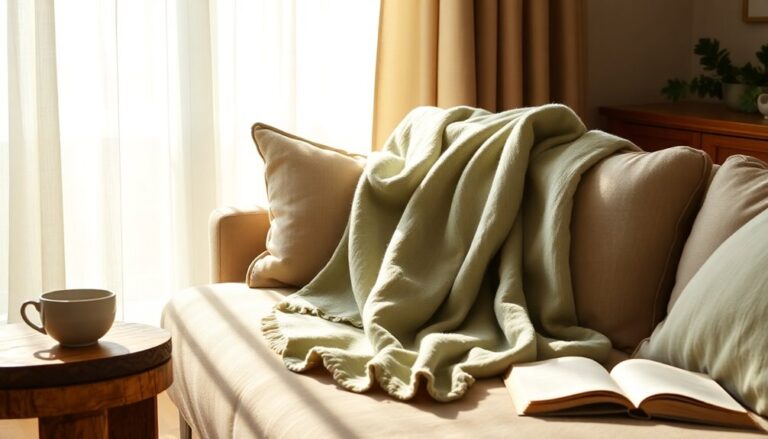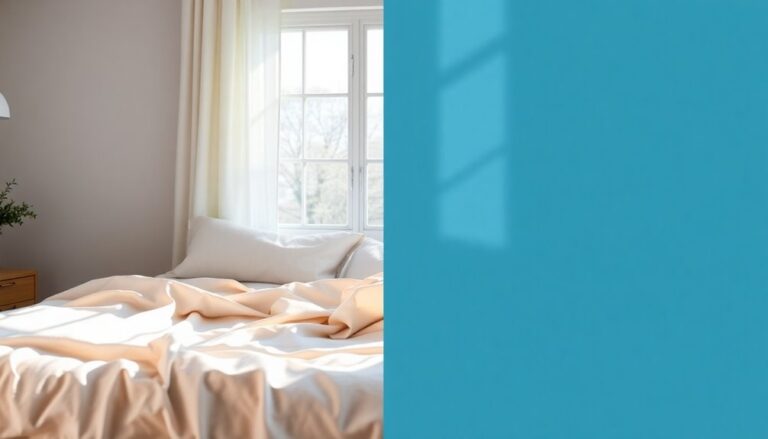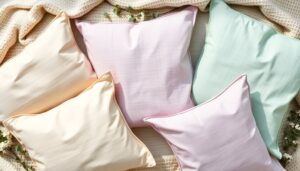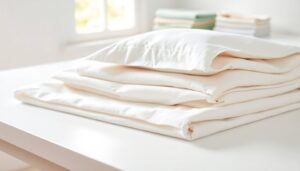Hotel linens and home linens differ mainly in quality, durability, and comfort. Hotel linens often feature higher thread counts and premium materials like cotton blends, providing a luxurious feel. They're designed for heavy use and frequent laundering, ensuring longevity. Home linens can be more cost-effective but may lack advanced moisture-wicking properties or the same softness. Many prioritize aesthetics over functionality. Discovering the nuances between the two can improve personal space and comfort. Explore further to uncover more insights.
Article Highlights
- Hotel linens typically feature higher thread counts and premium materials for a luxurious feel, while home linens often prioritize affordability and variety.
- Durability is a key focus for hotel linens, designed for heavy usage and frequent laundering, whereas home linens may wear out more quickly.
- Moisture-wicking properties are prevalent in hotel linens for comfort, while many home linens lack these advanced features, affecting sleep quality.
- Hotel linens create an inviting atmosphere reminiscent of luxury stays, while home linens emphasize personal style and comfort preferences.
- Cost considerations vary significantly, with budget home linens being affordable but less durable compared to luxury hotel linens that provide a superior sleeping experience.
The Importance of Thread Count

With regard to selecting linens, how crucial is thread count really? Many consumers often believe that a higher thread count guarantees superior quality, but this isn't always true. Thread count myths can mislead shoppers into thinking that more threads equal better luxury bedding. Although a higher count can indicate finer materials, it's not the sole factor determining comfort or durability. For instance, a thread count above 800 doesn't necessarily improve softness or longevity; it might just mean thinner threads are packed closely together. Instead, focusing on the quality of the fibers themselves often leads to more satisfying bedding choices. Comprehending these nuances helps consumers make informed decisions when choosing linens that offer both comfort and style for their homes.
Material Choices: Cotton, Polyester, and Beyond
With regard to hotel linens versus home linens, the selection of materials plays a crucial role in overall quality and comfort. Hotels often prefer cotton blends for their luxurious feel and breathability, while additionally ensuring durability. Home linens, conversely, may include more varied polyester options, which can be cost-effective and easy to care for.
| Material Type | Pros | Cons |
|---|---|---|
| Cotton Blends | Soft, breathable, durable | May wrinkle easily |
| Polyester Options | Affordable, wrinkle-resistant | Less breathable |
| Linen | Highly breathable, luxurious | More expensive, less common |
| Microfiber | Soft, stain-resistant | Less durable over time |
Understanding these material choices helps consumers make informed decisions for their bedding needs.
Durability and Longevity of Hotel Linens
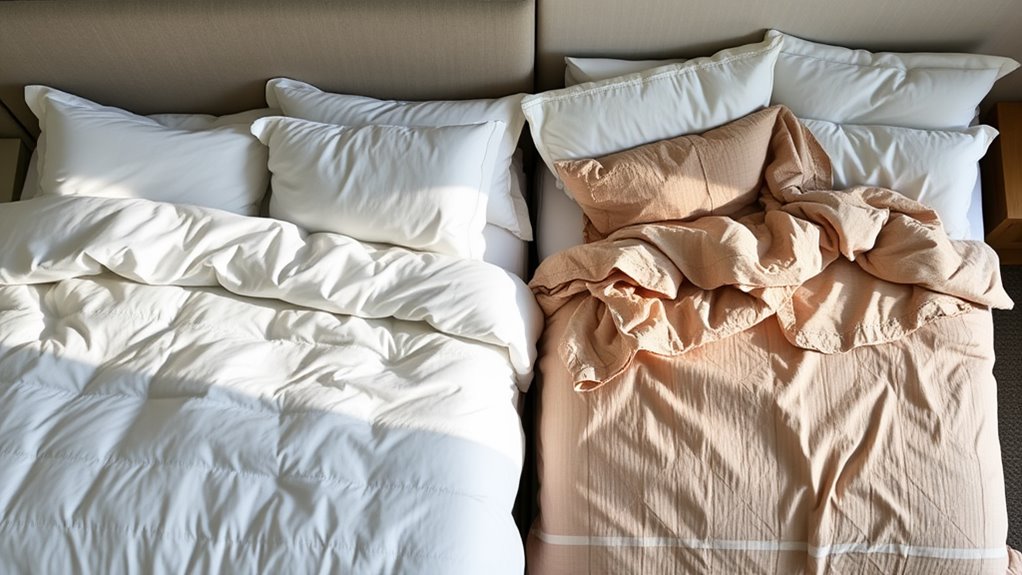
Though many might assume that luxury comes at a price, the durability and longevity of hotel linens often prove otherwise. Designed for heavy hotel usage and frequent laundry cycles, these linens are crafted to withstand the rigors of daily use.
- High thread counts for lasting strength
- Stain-resistant fabrics for easy maintenance
- Fade-resistant colors that endure washes
- Reinforced seams to prevent wear and tear
- Quick-drying materials to guarantee efficiency
The combination of quality materials and thoughtful design guarantees that hotel linens can maintain their fresh appearance longer than typical home linens. In the end, investing in such durability offers both functionality and peace of mind for hotels, making them a practical choice for many establishments.
The Feel: Softness and Comfort Levels
As far as softness and comfort are concerned, the materials used in hotel linens often set them apart from home linens. Hotel sheets typically feature higher thread counts and premium fabrics, which contribute to a luxurious feel. Home linens, although cozy, may not always match the same level of quality and comfort found in upscale hotel settings.
Material Quality Comparison
Even though many people may not realize it, the material quality of linens can greatly impact the overall comfort and softness experienced during sleep. Hotel linens often utilize superior material sourcing and refined production processes, ensuring a lavish feel that many home linens lack.
Consider the emotional benefits of high-quality linens:
- They improve relaxation after a long day.
- They provide a plush, inviting atmosphere.
- They promote better sleep, leaving one refreshed.
- They reduce irritation for sensitive skin.
- They create a luxurious experience reminiscent of a five-star stay.
Investing in quality materials transforms the mundane act of sleeping into a rejuvenating experience, making it clear why hotel linens often outshine their home counterparts.
Thread Count Differences
The difference in thread count between hotel linens and home linens plays a significant role in determining softness and overall comfort. Hotel linens often adhere to luxury standards, boasting higher thread counts that improve their tactile appeal. These linens typically feature thread counts ranging from 300 to 600, offering a silky feel that promotes relaxation. Conversely, many home linens may fall below this range, resulting in a coarser texture that might not provide the same level of comfort. Quality assurance in hotel linens guarantees not just durability but also a plush experience for guests. Ultimately, the higher thread count in hotel linens contributes to a more luxurious sleeping experience, making it an essential factor for those seeking ultimate comfort.
Maintenance and Care Requirements
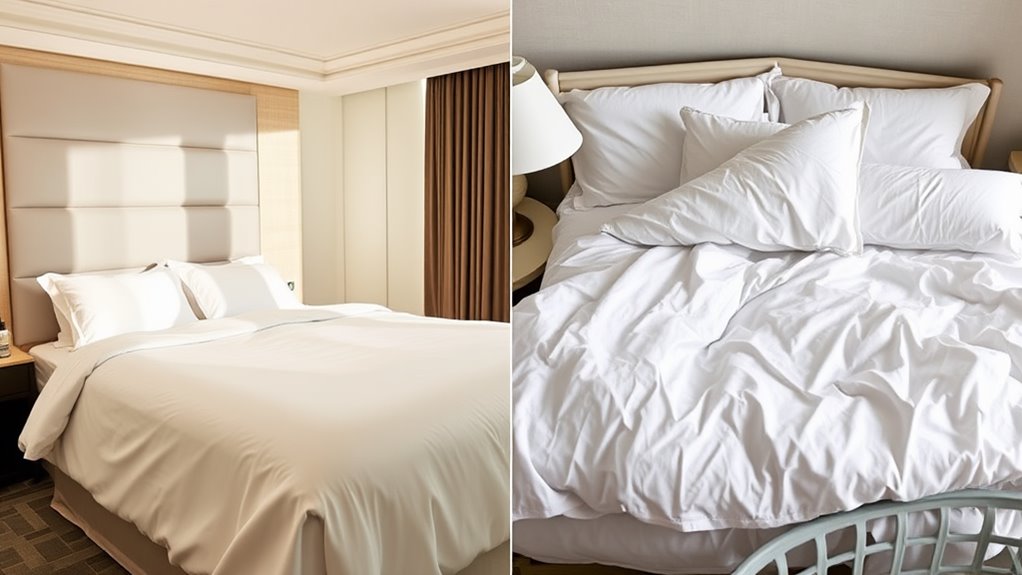
In terms of maintenance and care, hotel linens often require more rigorous washing frequencies compared to home linens. Stain treatment methods can likewise differ greatly, as hotels aim for pristine appearances at all times. Furthermore, the techniques for ironing and folding can vary, reflecting the need for a polished look in a hospitality setting.
Washing Frequency Differences
In many hotels, linens are washed daily due to high guest turnover, whereas home linens typically get cleaned every one to two weeks. This significant difference in washing routines highlights the varied laundry frequency between the two settings.
- Freshness is key for a comfortable stay.
- Clean sheets promote better sleep quality.
- Regular washing reduces allergens and irritants.
- It helps maintain a professional appearance in hotels.
- Home linens can accumulate odors and stains over time.
Understanding these differences can help homeowners appreciate the importance of regular maintenance, ensuring their linens remain as inviting as those found in hotels. In the end, adopting a more frequent washing routine can improve personal comfort and hygiene at home.
Stain Treatment Methods
Maintaining linens involves more than just regular washing; stain treatment plays a vital role in their upkeep. For both hotel and home linens, effective stain removal is important in preserving their quality and appearance. Different types of stains require specific cleaning solutions—whether it's a red wine spill or a greasy mark.
For instance, protein-based stains like blood or sweat often respond well to cold water and enzyme-based cleaners, whereas oil-based stains might need a degreasing agent. Timely attention to stains can prevent them from setting, making the overall cleaning process easier. Regularly inspecting linens for stains and treating them swiftly not only improves their longevity but also guarantees a fresh and inviting environment for guests or family alike.
Ironing and Folding Techniques
Though both hotel and home linens require proper ironing and folding techniques to guarantee a polished appearance, the methods can differ based on the specific needs of each setting. Hotels often use industrial-grade equipment, ensuring linens are perfectly pressed and neatly folded for a professional look. Conversely, home ironing techniques might be more relaxed, focusing on convenience.
To evoke a sense of care and attention, consider these key points:
- Crisp, wrinkle-free sheets improve comfort.
- Neatly folded linens create a welcoming atmosphere.
- Ironing techniques can prolong linen life.
- Proper folding methods save storage space.
- Attention to detail reflects personal style.
Understanding these differences helps in maintaining both hotel and home linens with pride.
Design and Aesthetic Appeal
How does the design and aesthetic appeal of linens influence the overall ambiance of a space? The right linens can transform a room, creating either a warm, inviting atmosphere or a sleek, modern vibe. Hotels often opt for luxury aesthetics, utilizing high-quality materials and elegant patterns that exude sophistication. In contrast, home linens may lean toward minimalist designs, focusing on simplicity and functionality. This difference in approach affects both the visual appeal and the emotional response of those using the space. During hotel linens aim to impress and offer a sense of indulgence, home linens can create a cozy and personal touch, balancing style with comfort. Ultimately, the choice of linens plays a vital role in defining a space's character.
Temperature Regulation and Breathability
When comparing hotel linens to home linens, the differences in fabric composition play a vital role in temperature regulation and breathability. Hotel sheets often feature moisture-wicking properties that keep guests comfortable throughout the night. Furthermore, many hotels invest in temperature control features that improve the overall sleeping experience, setting their linens apart from typical home options.
Fabric Composition Differences
The fabric composition of hotel linens often differs considerably from that of home linens, particularly regarding temperature regulation and breathability. Hotel linens typically utilize high-quality fabric blends that incorporate synthetic fibers, designed to withstand frequent washing whilst maintaining comfort. This improves their ability to keep guests cool in summer and warm in winter.
- Enhanced temperature control
- Superior breathability for a restful sleep
- Durable materials that last longer
- Softness that feels luxurious against the skin
- Easy maintenance for busy lifestyles
In contrast, home linens may prioritize aesthetics over functionality, often sacrificing breathability for style. Comprehending these differences can lead to more informed choices when selecting bedding that promotes a better night's sleep.
Moisture-Wicking Properties
As fabric composition plays a notable role in the overall comfort of linens, moisture-wicking properties are equally important for temperature regulation and breathability. Hotel linens often feature advanced moisture management technologies that draw sweat away from the body, keeping sleepers dry and comfortable throughout the night. This is particularly beneficial in environments where guests may experience varying temperatures.
In contrast, many home linens may lack these innovative features, potentially impacting comfort during sleep. Moisture-wicking materials help prevent the accumulation of moisture, which can lead to discomfort and disrupted sleep. By effectively managing moisture, these linens improve the overall comfort impact, ensuring a more restful experience for users. In the end, choosing linens with superior moisture-wicking properties can greatly raise the quality of sleep.
Temperature Control Features
Though many factors contribute to a good night's sleep, temperature control features in linens play a crucial role in improving comfort. Hotel linens typically utilize advanced temperature regulation methods, ensuring ideal breathability and insulation properties. This allows guests to enjoy a restful night, regardless of the season.
Here are some key benefits that highlight the importance of temperature control in linens:
- Keeps you cool during hot nights
- Provides warmth in colder temperatures
- Reduces night sweats and discomfort
- Improves overall sleep quality
- Promotes a restful environment
In contrast, home linens may lack these sophisticated features, often resulting in fluctuating temperatures that can disturb sleep. Prioritizing temperature control can make all the difference for a rejuvenating night's rest.
Cost Considerations: Budget Vs Luxury
When considering the cost of linens, individuals often find themselves weighing budget-friendly options against luxury choices. Budget considerations typically lead shoppers to prioritize affordability, often opting for materials that are less expensive but still functional. These linens may not boast the same durability or aesthetic appeal as their pricier counterparts but can fulfill everyday needs effectively. Conversely, luxury preferences drive some consumers toward higher-end fabrics and elaborate designs, providing an indulgent sleeping experience. Although these luxury linens often come with a higher price tag, they can improve comfort and style in the bedroom. In the end, the choice between budget and luxury linens hinges on individual priorities, lifestyle, and how much one values quality versus cost.
Sizing and Fit: Standard Vs Custom Options
Choosing the right linens goes beyond just cost; sizing and fit play a significant role in overall satisfaction. Hotel linens often come in standard sizes, designed for efficiency and uniformity. Nevertheless, custom fit options can boost the experience, providing a personalized feel that standard sizes might lack.
Consider these emotional aspects when choosing linens:
- Comfort that wraps you like a warm hug
- Aesthetic appeal that improves your space
- Durability that withstands everyday use
- Quality that guarantees a good night's sleep
- Satisfaction that comes from a perfect fit
Investing in custom fit linens can transform a simple bed into a luxurious retreat, whereas standard sizes may not always meet individual needs.
Tips for Creating a Hotel-Like Experience at Home
Creating a hotel-like experience at home can improve your daily routine and transform your personal space into a serene retreat. To achieve this, start by investing in quality linens that offer a soft, luxurious feel, similar to those found in upscale hotels. Layering bedding with plush throws and decorative pillows adds those crucial luxury touches. Incorporating ambient lighting, such as soft lamps or dimmable fixtures, can create a calming atmosphere perfect for unwinding. Moreover, consider adding scented candles or aromatic oil diffusers to evoke a soothing scent reminiscent of a spa. Finally, maintain a clutter-free environment to promote tranquility, allowing your home to feel like a personal sanctuary where relaxation reigns supreme.
Frequently Asked Questions
Are Hotel Linens Treated With Special Chemicals or Finishes?
One might wonder if the comforts of a hotel stay come with hidden secrets. Certainly, hotel linens often undergo chemical treatments and fabric finishes to improve durability and stain resistance. These processes guarantee that sheets and towels can withstand frequent washing as they maintain a crisp, fresh appearance. Although home linens may not always receive such specialized care, comprehending these treatments sheds light on why hotel linens feel so pristine and inviting.
Can Hotel Linens Be Used for Everyday Home Use?
When considering whether hotel linens can be used for everyday home use, one must weigh luxury comfort against durability factors. Many hotel linens are designed for frequent use, offering exceptional durability that could benefit a household. Nevertheless, their luxurious feel might not be necessary for daily living. In the end, it's about personal preference; if someone values the upscale experience, incorporating hotel-quality linens into their home could improve their comfort and satisfaction.
How Often Do Hotels Replace Their Linens?
In a vibrant domain of comfort, where weary travelers seek rest, linen replacement frequency becomes paramount. Hotels, like diligent guardians, adhere to strict hotel laundering practices. Typically, they replace sheets and towels every few days, guaranteeing freshness reigns supreme. This routine not merely upholds cleanliness but additionally improves guest experience. By maintaining such standards, hotels guarantee their domain remains inviting, allowing guests to feel cherished and rejuvenated during their stay.
Do Hotel Linens Have a Specific Lifespan?
Hotel linens do have a specific lifespan, influenced by factors like usage frequency and quality. Higher usage leads to more wear and tear, often shortening their lifespan. Typically, hotels replace linens every few years, but this can vary based on the volume of guests and washing methods. Proper care can extend their usability, but eventually, even the best linens can't withstand constant laundering and wear, necessitating timely replacements to maintain comfort and cleanliness.
Are There Eco-Friendly Options for Hotel-Quality Linens?
One might assume that hotel-quality linens are all about luxury and excess, but ironically, the industry is shifting in the direction of sustainability. Many hotels are now opting for eco-friendly options, utilizing sustainable materials that boast organic certifications. These linens not merely provide the comfort expected but furthermore minimize environmental impact. By choosing such products, hotels can improve their appeal during contributing positively to the planet, proving that luxury and eco-consciousness can truly coexist.





